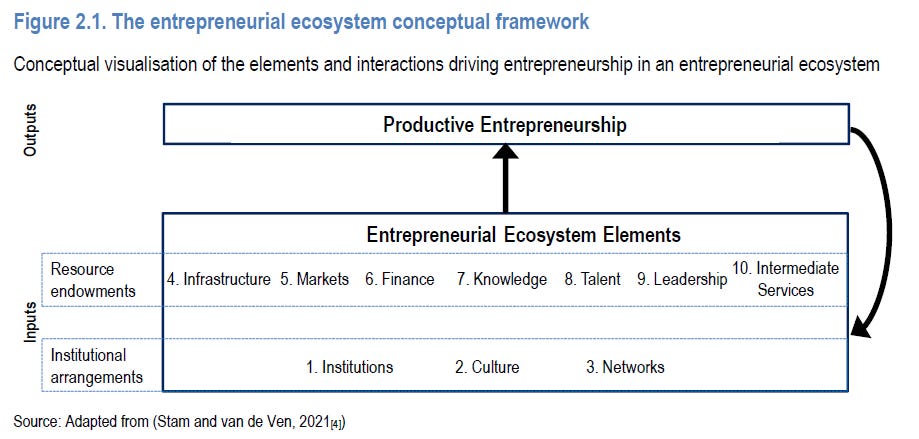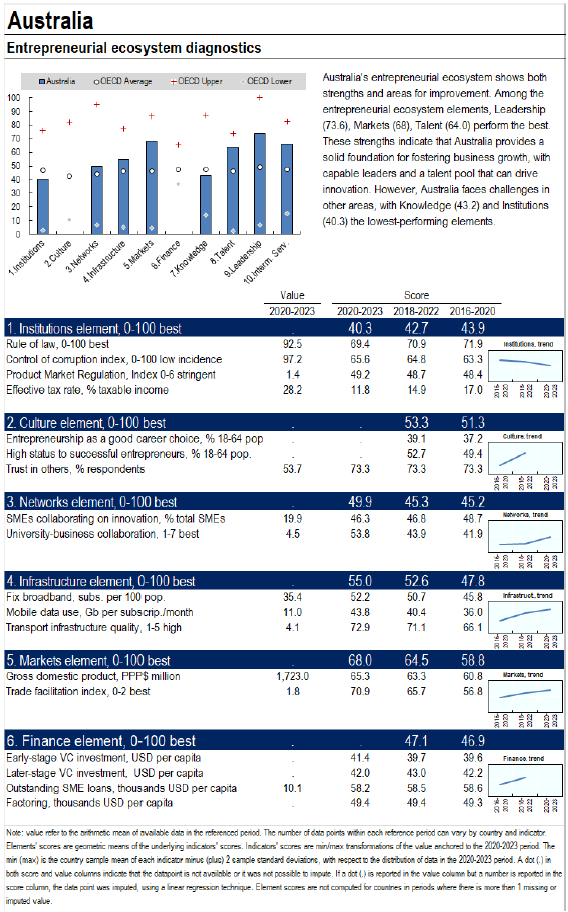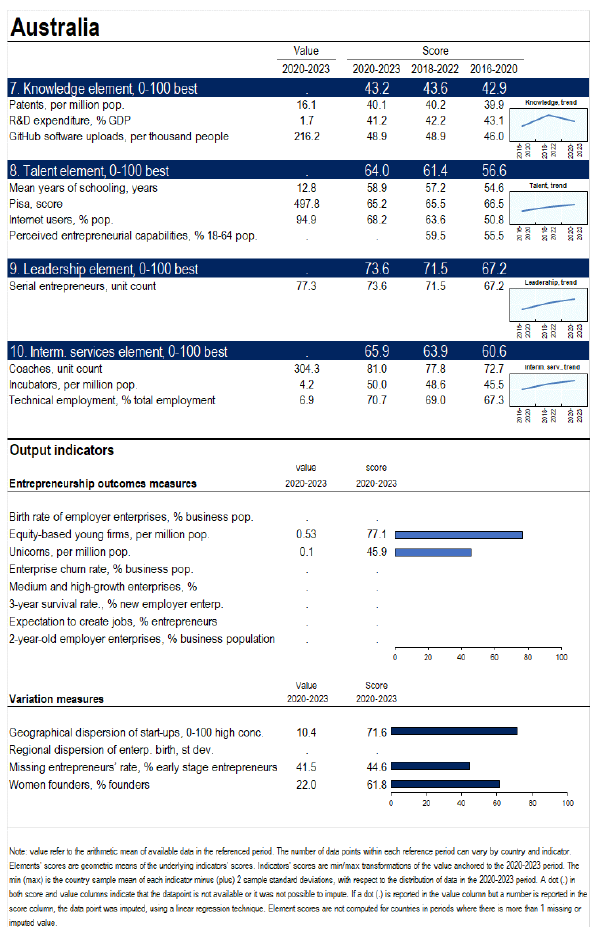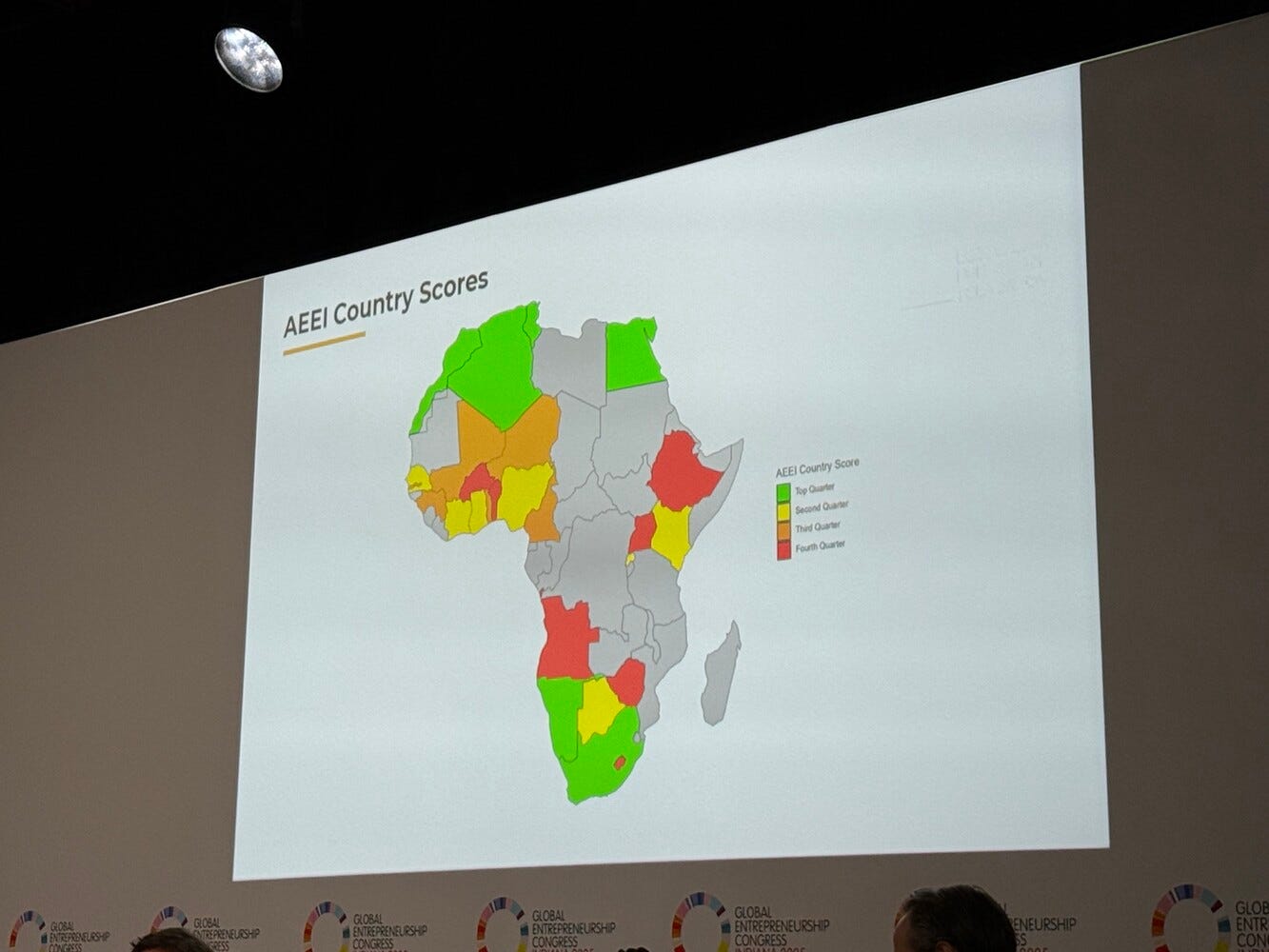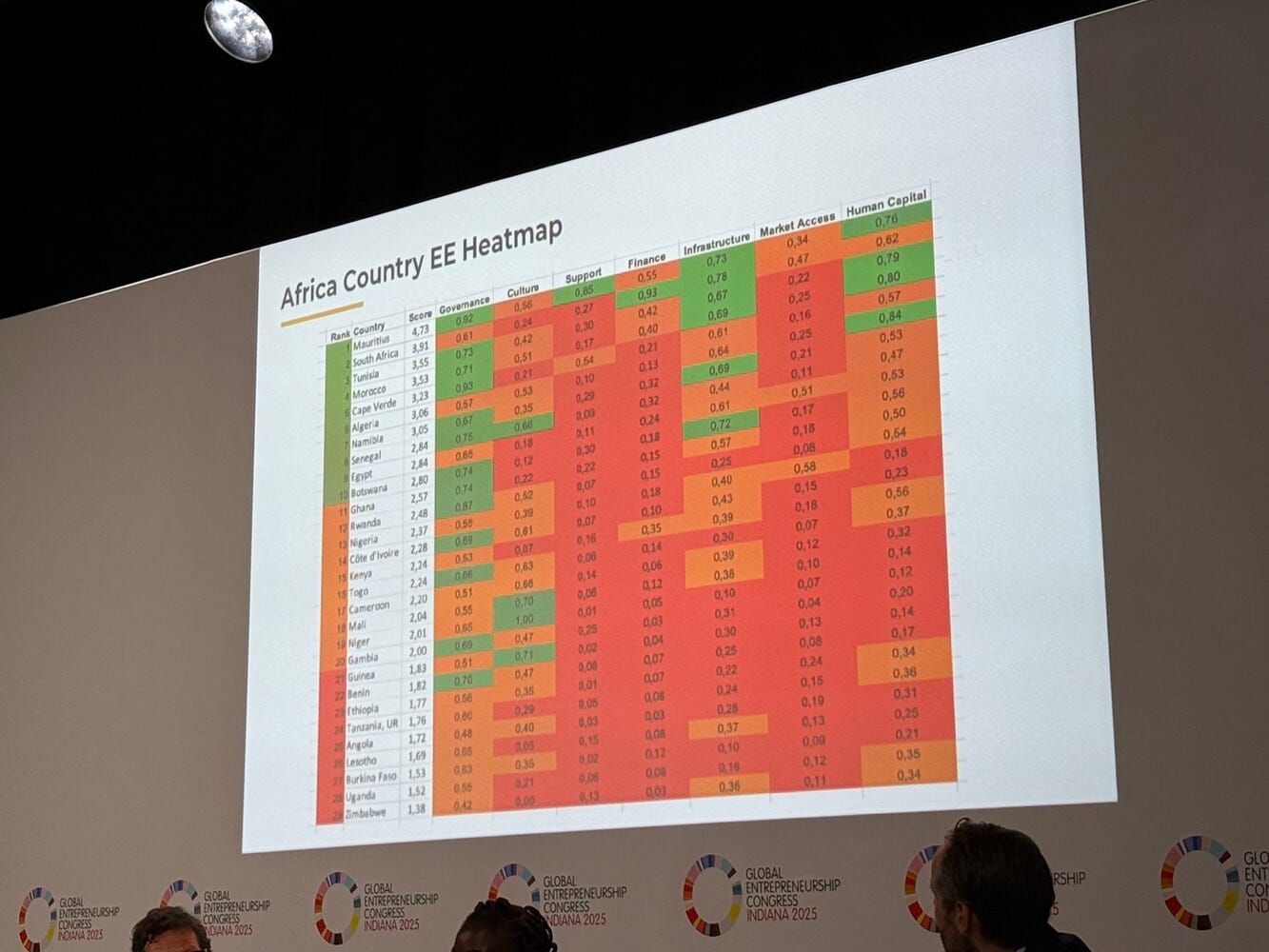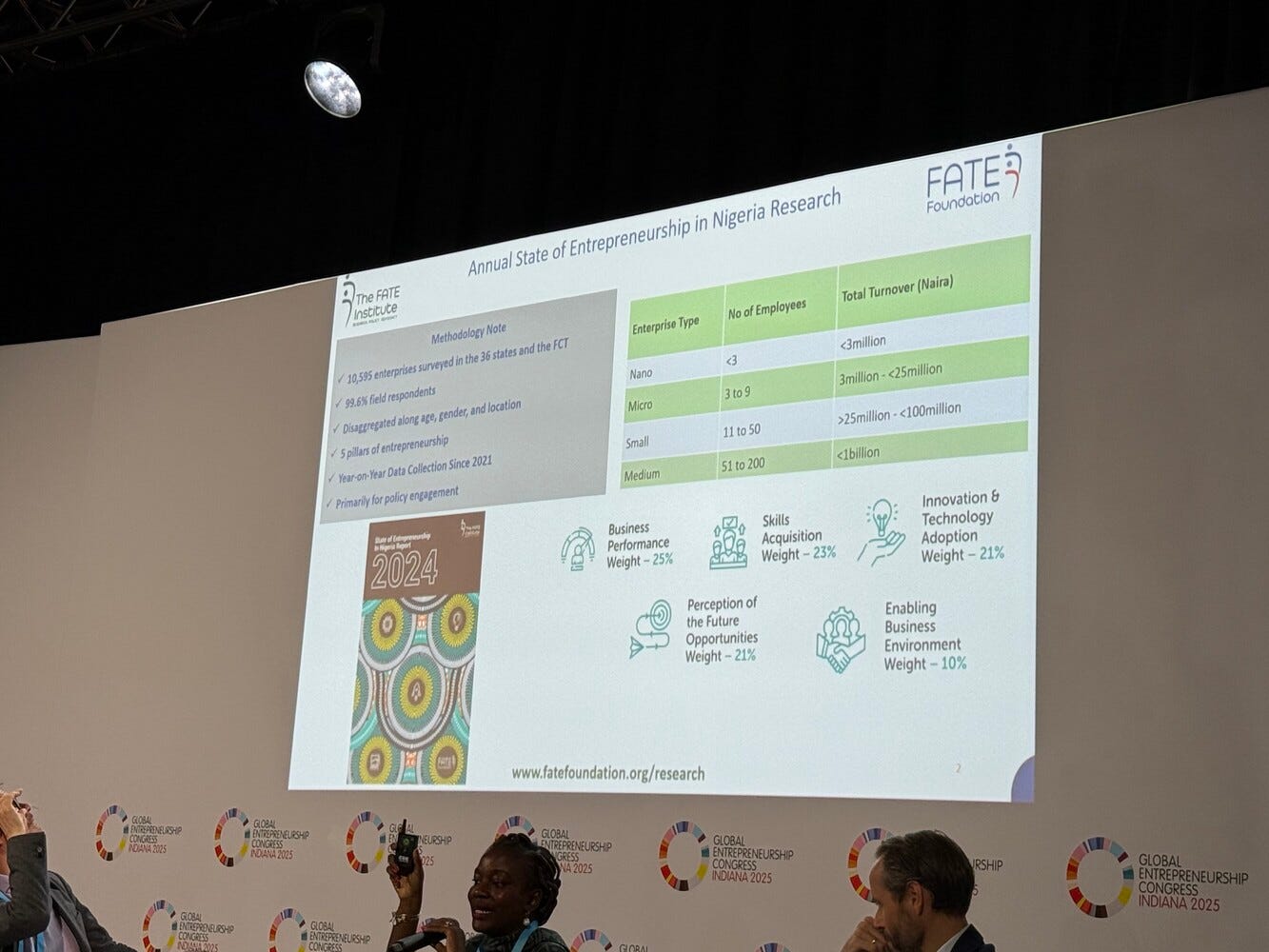OECD 2025 Entrepreneurial Ecosystem Diagnostics report: Critique and review
What metrics are important for entrepreneur ecosystems? And by looking at entrepreneur ecosystems, what might we be missing?
A new OECD report on Entrepreneurial Ecosystem Diagnostics, released at the Global Entrepreneurship Congress (GEC) in Indianapolis, Indiana, proposes to get us closer to some answers. The presentation panel included Jonathan Potter, Adenike Adeyemi, Christopher Haley, Erik Stam, and Phumlani Nkontwana.
Prepared by Roberto Crotti , Jonathan Potter, Pablo Shah and Erik Stam, the 2025 report presents data to help assess the state and evolution of national entrepreneurial ecosystems in OECD countries. The report offers a diagnostic tool highlighting ecosystem strengths and weaknesses, pointing to where policy action may need to be reinforced. The pilot exercise represents the first time such a benchmarking has been produced for all OECD countries, while building on long-standing OECD work, including the OECD-Eurostat Entrepreneurial Indicators Programme.
The report aims to:
Identify areas of strength and weakness in their entrepreneurial ecosystem conditions;
Start policy dialogues with entrepreneurial ecosystem actors on the nature and causes of bottlenecks and the potential responses;
Monitor progress in entrepreneurial ecosystem conditions over time;
Offer data for more detailed analysis of the functioning of entrepreneurial ecosystem inputs and outputs; and
Motivate longer-term investments to improve entrepreneurship data and indicators.
A personal journey with mapping indicators
People will engage with the report based on their background and current frame of reference, be it policymakers, practitioners, investors, activists, community members, or entrepreneurs. My personal frame of reference is below.
My early interest in metrics can be seen as a means to make the unknown known and to bring control to complexity. Management of metrics was a matter of life and death in my five years on submarines in the US Navy. In building production and quality systems in our US and Australian-based printed circuit board manufacturing companies, I tracked chemicals to the ounce, electricity to the watt., time to the second, and dollars to the decimal cent. In our digital agency, we developed systems to track internal billable rates, quality issues, and profitability alongside client engagement, transactions, and return on investment.
Moving to personal development in the social sciences, consulting, and coaching, I was attracted to frameworks that proposed to help us understand individual and team dynamics through types and profiles. I eventually ended up managing an innovation hub, where I set about building systems to understand the innovation and entrepreneur ecosystem.
Each shift in my career has led me to move into areas of increasing complexity and uncertainty. My PhD was a wrestling with ambiguity and tension I experienced in advancing innovation and entrepreneurship, with the unintended negative consequences for communities.
Some early pre-PhD writing attempted to correlate metrics of innovation ecosystems with measures of community resilience (Mapping innovation ecosystems to community resilience Nov 2017). Through 2018 and 2019, I worked on projects relating to state and national innovation metrics, including the Office of the Queensland Chief Entrepreneur and managing the 2019 Global Entrepreneurship Monitor for Australia. I also founded the not-for-profit Startup Status, which included a software platform to reconcile and integrate the innovation and social impact domains.
In January 2020, I consolidated research into metrics and advocated for greater national leadership in innovation data and metrics, with posts including:
Exploring the Australian context: Regional business density and Australian R&D investment
Regional adaptive capacity – reviewing the 2017 Productivity Commission Study Report
A use case approach to developing ecosystem metrics
Australia’s improving innovation indicators – a brief review
OECD report on Australian Entrepreneurship and the Entrepreneurship Indicators Programme
Innovation and Science Australia’s 2016 Performance Review of the Australian Innovation, Science and Research System
Using data for a narrative of the Australian innovation system
This was as much as me wrestling with what could be known as a clear call to action, in preparation for an Australian entrepreneur ecosystem measurement survey and panel session at the 2020 Australian Centre for Entrepreneurship Research Excellence (ACERE) conference. In October 2023, I consolidated my findings on the growth of the ecosystem in the journal paper "The Evolution of the Australian Start-up and Innovation Ecosystem: Mapping Policy Developments, Key Actors, Activities, and Artefacts." I have also, over the years, mapped approaches to mapping, with the latest update in August 2024: Australian innovation metrics and a 2024 update to systems and platforms for mapping and measuring innovation ecosystems.
Over the years, I became increasingly aware of gaps in approaches to innovation and entrepreneurship evaluation. My June 2024 post on the Australian review of the 2024 Global Startup Ecosystem Report (GSER) graphed the weighted percentages of indicators that contribute to a high or low global ranking. My conclusion was that a country can rank high in innovation at the expense of and perhaps because of increased inequality. I questioned whether the entrepreneur ecosystem, as a concept, stretched far enough to encompass all the parts of the community it purported to help.
Which brings us to my current perspective. In January 2024, I embarked on a new project Ready Communities as a place-based framework with my co-founder Kerry Grace. Our emphasis is on the enabling conditions that support a community through a Readiness Index. While innovation and entrepreneurship are an important part of the approach, it is integrated with a holistic view of place-based development. The premise is that impact is realised with readiness factors at the community level.
It is with this lens that I review and welcome the recent OECD report. It is essential to have a shared understanding of what matters in any context, whether it is entrepreneurship, innovation, wellbeing, readiness, resilience, or equality. If I have learned anything over the past few decades, it is that developing a shared understanding of complexity across diverse contexts is hard work. The effort that has gone into this report should be commended even as it is critiqued and practically applied.
Report indicators and application
The entrepreneur indicators are based on a framework put forward by Erik Stam and Andrew van de Ven in their paper Entrepreneurial ecosystem elements. Features of the model include a separation of inputs from outputs, distinguishing inputs as institutional arrangements and resource endowments, linking inputs to each other and outputs, and acknowledging the recursive feedback loops between outputs and inputs.
The framework includes 29 indicators across the ten input elements and 11 indicators across the two output parts. An interpretation of the indicators is outlined in the diagram below, as I find infographics helpful to conceptualise what is being assessed in a single image. The report also includes detailed descriptions and the source for each indicator.
The remainder of the report then applies the indicators to the national contexts, providing country comparisons and in-depth country overviews.
The panel session also included a provocation by one of the pioneers of entrepreneurial research, Daniel Isenberg, who raised a question about the report's intended audience being only one species in the ecosystem of policymakers. This was responded to in part by the panel, but the conversation raised the value of in-person events going beyond general information and into deeper discussion and debate.
The report was supported by presentations from Chris Healey from Startup Genome and Erik Stam, a contributor to the report. Phumlani Nkontwana, founding director of the Allan Gray Centre for Africa Entrepreneurship, shared about the gaps in entrepreneurial research applicable in the African context and their approach to rating entrepreneurial drivers in Africa.
Adenike Adeyemi from the FATE Foundation shared perspectives on mapping impacts in Nigeria including a focus on Youth Entrepreneurship.
Reflections and next steps
The report, the panellists' presentations, and the subsequent discussions highlight the depth of thinking that has gone into understanding the conditions that contribute to successful entrepreneur ecosystems. The introduction in the report acknowledged known potential criticisms, including a preference for regional over national, a lack of empirical evidence on ecosystem inter-relationships, a typical emphasis on growth-oriented startup entrepreneurship, and a preference for clusters or innovation systems instead of entrepreneur ecosystems. But as a rigorous attempt at cross-country analysis, the report should be commended.
One question raised in the session Q&A related to timeliness, in how the information can be provided in a more real-time basis. The rate of change facing economies around the world necessitates a more rapid feedback loop. Many of the indicators are delayed, resulting in greater delays in cross-nation aggregation. This might require greater cross-country collaboration on shared measures.
Another concern I raised related to a reliance on market-based data sources. For example, the randomised phone survey approach of the Global Entrepreneurship Monitor can be costly to deliver. In Australia, without federal government commitment, delivery is reliant on an academic or private-sector funding source. Without funding, Australia will not be represented in either the GEM breakdowns or aggregate rankings like the recent OECD report.
I also raised a concern about the ranking models inherent to any index. The report authors were clear on the intent of the ranking to enable conversations rather than be used to compare higher or lower rankings between countries, particularly given the impact of local context. It is inevitable, however, that rankings will coincide with press releases to score political points one way or another.
My main critique, however, relates to what is not being measured in entrepreneur ecosystems. Innovation in most developed economies contributes to inequality and success entrepreneurship factors can come at the expense of marginalised communities. The OECD report is the first among popular indexes to go a step in this direction by reporting on variability based on gender, geography, and 'missing' entrepreneurs. However, other indicators, such as wealth distribution, would be helpful to visibly highlight the potential cost of a high entrepreneurial ranking. It is not that a country would not aspire to have a high ranking, but that policymakers could make an informed decision about additional measures to consider when replicating policies.
As a call to action from the report, we can advocate for policymakers at the national level to engage with the report, invest with the OECD in national datasets so as to participate in cross-country analysis, and consider policies that address areas for improvement while maintaining areas of strength.
On a personal note, it was amazing to be in the room with leaders whose work has informed my thinking over the years. I look forward to continuing the conversation even as we focus on place-based work. As always, feedback, comments, corrections, and critiques are welcome.





